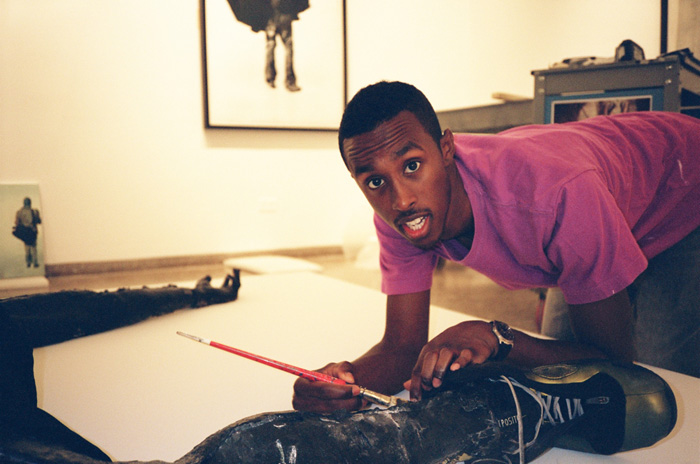Portrait of an Artist, Among Many Clips

PORTRAIT BY JACK SIEGEL
Among the prizes Abdi Farah took home last week for winning Bravo’s Work of Art: The Next Great Artist were a cool $100,000 and a chance to show at the Brooklyn Museum.
Work of Art: Abdi Farah features the ebullient graphic figurative sculptures, paintings, and sketches that won him the final challenge on the reality show. The three finalists–Farah, Miles Mendenhall and Peregrine Honig–were each given $5,000 and three months of studio time to create an exhibition.
When presented to the judges of Work of Art, Farah’s show was originally titled Luminous Bodies, inspired by a Star Wars scene where Yoda says to Luke Skywalker, “Luminous beings are we, not this crude matter.” At its centerpiece are dark, larger-than-life-size figures–these sort of angel-athlete reliefs stretched out on the gallery floor. The work is on view now through October 17 in the Brooklyn Museum’s fifth-floor Projects Gallery.
PHOTO BY JACK SIEGEL
“It’s really cool because people get to see the work actually in person,” Farah said of the Brooklyn show on Tuesday. “TV does a good job, but nothing makes up for seeing the work in person.”
Critics, more forcefully than Farah, have argued just that point: What is the television viewers’ ability to actually “see” the work on the show?
The Los Angeles Times‘ Christopher Knight blogged, “I would no more review art from reproductions on a museum’s website or in a magazine than I would from seeing it on a TV show.” This goes without saying, but no matter how good the lighting or the number of camera angles, it’s impossible to interact with an art work when filtered through this other medium. On screen, when you can’t quite catch all of the differences in texture and volume, sometimes sculpture just looks like, well, crude matter.
Farah’s win was considered an upset over frontrunner Mendenhall, the most consistently well-received contestant over the course of the show. In conversation, the 23-year-old Farah comes off as confident in his abilities while diplomatic about the outcome.
“I feel like as an artist it’s hard to judge your own work objectively. I was impressed by Miles’ show and Peregrine’s show,” Farah said. “I think that any of the three of us could have won… At the end of the day, it is subjective and that’s one of the cool things about it. You can judge it, you can critique it but at the end of the day there isn’t one supreme answer [among the judges] and that makes it a lot more fun.”
He is surprised by the warm response to his Brooklyn Museum show, which opened Saturday. People seem to really “appreciate” the work, he said. Moving forward, Farah said he’s sinking some of that prize money into producing more sculptural work. That medium, he’s realized, is much more cost-heavy than painting: “The sculpture I did in the finale cost over $2000-way more than all nine or however many paintings I made combined [over the course of the show].”
“I’m really just back to work just full tilt, on my grind, just try to make a lot of art. I feel like my time on Work of Art just really inspired me so greatly in my practice,” Farah said. “I have probably too many ideas for the amount of time I have, but I think that’s always the best thing for an artist.”
WORK OF ART: ABDI FARAH IS ON VIEW THROUGH OCTOBER 17. THE BROOKLYN MUSEUM IS LOCATED AT 200 EAST PARKWAY, BROOKLYN.






